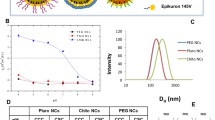The presence of anti-polyethylene glycol (PEG) antibodies can limit the clinical efficacy of PEGylated drugs and cause anaphylactic reactions in patients. Monocytes/macrophages are effector cells involved in IgG-mediated passive systemic anaphylaxis. We studied the influence of human blood serum on the efficiency of uptake of PEGylated nanoparticles by human blood monocytes. It has been shown that magnetic nanoparticles modified with PEG-3000 and solid lipid nanoparticles containing PEG-2000 are avidly internalized by human blood monocytes in vitro, the uptake efficiency depends on the features (composition) of donor blood serum, but does not correlate with the level of the IgG antibody against PEG.
Similar content being viewed by others
References
Chen BM, Cheng TL, Roffler SR. Polyethylene glycol immunogenicity: theoretical, clinical, and practical aspects of anti-polyethylene glycol antibodies. ACS Nano. 2021;15(9):14 022-14 048. doi: https://doi.org/10.1021/acsnano.1c05922
Sellaturay P, Nasser S, Ewan P. Polyethylene glycol-induced systemic allergic reactions (anaphylaxis). J. Allergy Clin. Immunol. Pract. 2021;9(2):670-675. doi: https://doi.org/10.1016/j.jaip.2020.09.029
Jönsson F, Mancardi DA, Zhao W, Kita Y, Iannascoli B, Khun H, van Rooijen N, Shimizu T, Schwartz LB, Daëron M, Bruhns P. Human FcγRIIA induces anaphylactic and allergic reactions. Blood. 2012;119(11):2533-2544. doi: https://doi.org/10.1182/blood-2011-07-367334
Escribese MM, Rosace D, Chivato T, Fernández TD, Corbí AL, Barber D. Alternative anaphylactic routes: the potential role of macrophages. Front. Immunol. 2017;8:515. doi: https://doi.org/10.3389/fimmu.2017.00515
Bigini P, Gobbi M, Bonati M, Clavenna A, Zucchetti M, Garattini S, Pasut G. The role and impact of polyethylene glycol on anaphylactic reactions to COVID-19 nano-vaccines. Nat. Nanotechnol. 2021;16(11):1169-1171. doi: https://doi.org/10.1038/s41565-021-01001-3
Yang Q, Jacobs TM, McCallen JD, Moore DT, Huckaby JT, Edelstein JN, Lai SK. Analysis of pre-existing IgG and IgM antibodies against polyethylene glycol (PEG) in the general population. Anal. Chem. 2016;88(23):11 804-11 812. doi: https://doi.org/10.1021/acs.analchem.6b03437
Demin AM, Pershina AG, Minin AS, Mekhaev AV, Ivanov VV, Lezhava SP, Zakharova AA, Byzov IV, Uimin MA, Krasnov VP, Ogorodova LM. PMIDA-modified Fe3O4 magnetic nanoparticles: synthesis and application for liver MRI. Langmuir. 2018;34(11):3449-3458. doi: https://doi.org/10.1021/acs.langmuir.7b04023
Lv X, Zhang C, Shuaizhen Q, Yu R, Zheng Y. Design of integrin αvβ3 targeting self-assembled protein nanoparticles with RGD peptide. Biomed. Pharmacother. 2020;128:110236. doi: https://doi.org/10.1016/j.biopha.2020.110236
Reyes-González JM, Armaiz-Peña GN, Mangala LS, Valiyeva F, Ivan C, Pradeep S, Echevarría-Vargas IM, Rivera-Reyes A, Sood AK, Vivas-Mejía PE. Targeting c-MYC in platinum-resistant ovarian cancer. Mol. Cancer Ther. 2015;14(10):2260-2269. doi: https://doi.org/10.1158/1535-7163.MCT-14-0801
Lubich C, Allacher P, de la Rosa M, Bauer A, Prenninger T, Horling FM, Siekmann J, Oldenburg J, Scheiflinger F, Reipert BM. The mystery of antibodies against polyethylene glycol (PEG) — what do we know? Pharm. Res. 2016;33(9):2239-2249. doi: https://doi.org/10.1007/s11095-016-1961-x
Bournazos S, Gupta A, Ravetch JV. The role of IgG Fc receptors in antibody-dependent enhancement. Nat. Rev. Immunol. 2020;20(10):633-643. doi: https://doi.org/10.1038/s41577-020-00410-0
Author information
Authors and Affiliations
Corresponding author
Additional information
Translated from Byulleten’ Eksperimental’noi Biologii i Meditsiny, Vol. 175, No. 2, pp. 239-243, February, 2023
Rights and permissions
Springer Nature or its licensor (e.g. a society or other partner) holds exclusive rights to this article under a publishing agreement with the author(s) or other rightsholder(s); author self-archiving of the accepted manuscript version of this article is solely governed by the terms of such publishing agreement and applicable law.
About this article
Cite this article
Nevskaya, K.V., Krivoshchekov, S.V., Zima, A.P. et al. The Level of Anti-Polyethylene Glycol (PEG) Immunoglobulin G Antibodies in Human Serum Does Not Correlate with Efficiency of PEGylated Nanoparticle Uptake by Monocytes. Bull Exp Biol Med 175, 270–274 (2023). https://doi.org/10.1007/s10517-023-05848-5
Received:
Published:
Issue Date:
DOI: https://doi.org/10.1007/s10517-023-05848-5




